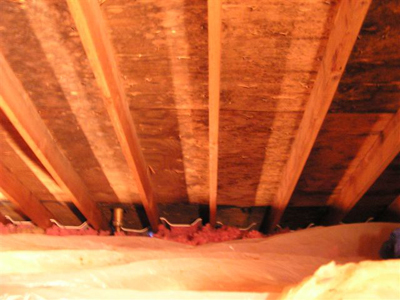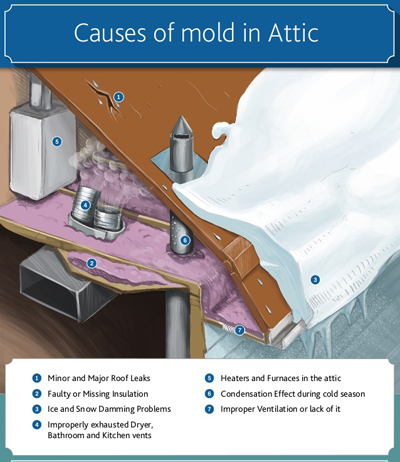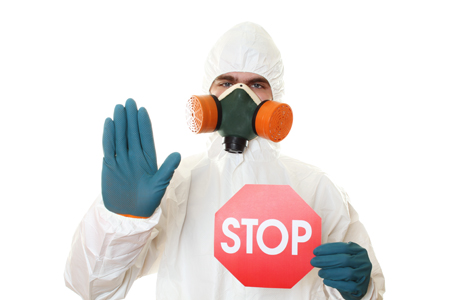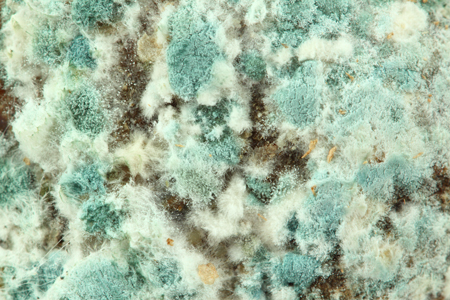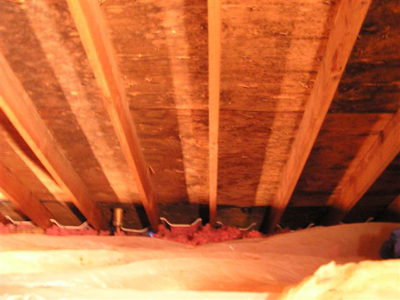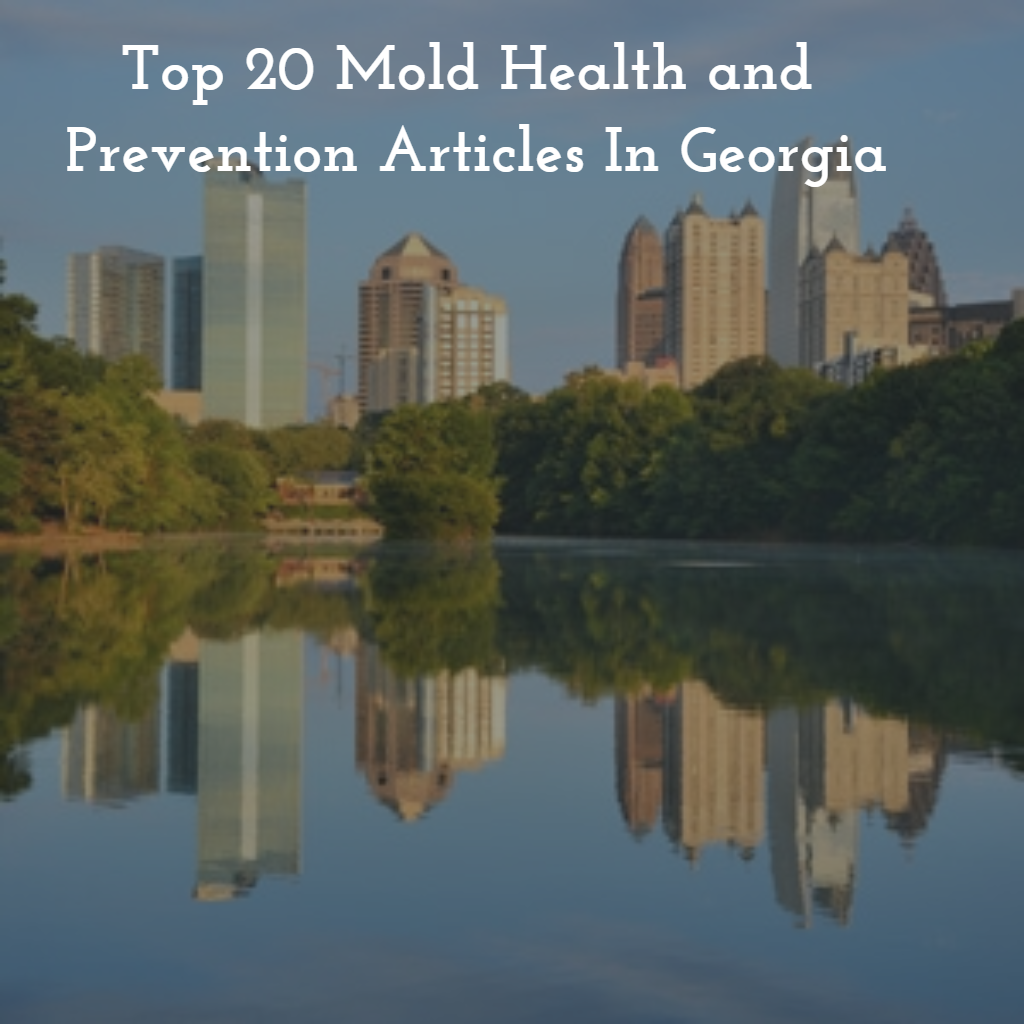
by Eric Brown | Mar 4, 2016 | Attic Mold, Bleach and Mold, Dead Mold Spores, Health, Indoor Air Quality, Killing Mold, Mold Facts, Mold Information, Mold Inspection, Mold Remediation, Mold Removal, Questions and Answers
Top 4 Reasons Mold Grows In Your Attic!
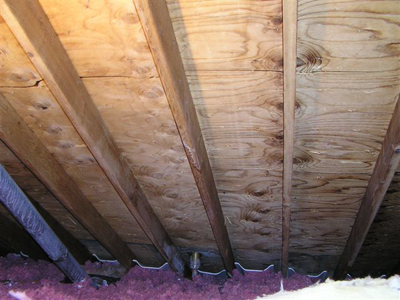
Top 4 Reasons Mold Grows In Your Attic!
Mold B Gone has been very busy this year doing many attic mold remediation projects.
The purpose of this blog is to explain why you have mold in your attic.
Four Common Causes Of Mold Growth In The Attic
Causes Of Attic Mold: A Leaking Roof
If you have a roof leak, you may see water on your floors and water stains on the ceiling. The good news, you know that you have a problem.
However, if you have a roof leak and it goes unnoticed leading to moisture accumulation in your attic, this will eventually lead to mold growth that you may not even know exists.
This is the reason it is important to inspect your attic several times each year, just to make sure that there is no moisture buildup.
- Check for discoloration of insulation and wood (e.g. rafters, sheathing, joists, attic side of fascia boards, etc.).
- Check roof valleys (i.e. where two roofs join at an angle), which are highly susceptible to roof leaks.
- Observe skylights, chimneys, attic windows and any portion of the attic/roof where dissimilar materials join each other (including flashings). These places are hotbeds for potential moisture intrusion.
- If you have a vapor barrier installed, check for condensation. Although this is not really a roof leak, it is nevertheless a sign of a moisture problem. And moisture problems lead to attic mold problems!
- Make sure there are no leaks coming from and around attic plumbing stacks.
The first step to addressing the moisture cause is to get your roof repaired, then call us to remove the mold.
Causes Of Attic Mold: Missing Insulation or Improperly Installed Insulation
The quest to save money on heating and cooling bills motivates many Do-It-Yourselfer’s to install more insulation in their attics.
Unfortunately, if the wrong kind of insulation is chosen or if it is installed improperly, this can cause moisture from the lower levels of your home to rise and get trapped in the attic.
As we have written before, the primary cause of mold growth is moisture. Your attic is made of the food mold loves to feed on.
With respect to the type of insulation, if you are layering insulation on top of other insulation, make sure you do not use the kind that has paper or foil backing because it acts as a vapor barrier and can trap moisture in the insulation.
Before you decide to add more insulation to your attic, determine if you need more first. If you are unsure, contact a professional.
Causes Of Attic Mold: Inadequate Attic Ventilation
One of the problems we have encountered in our projects is the fact that insulation is blocking the ventilation ducts that distribute air in the attic.
The lack of ventilation is another major cause of mold growth in your attic.
Air travels up to the attic meaning activities such as cooking, bathing, showering, etc will produce moisture that will makes it way up to the attic. If there is poor ventilation, the moisture gets trapped in the attic and can lead to mold problems.
Check your soffit vents and make sure they are free of insulation, bird nests, and other debris that could be blocking them and preventing proper air flow.
If you are unsure if the ventilation is ideal in your attic, contact a home inspector or give us a call so that we can take a look.
Causes Of Attic Mold: Fans Vented Into The Attic
Mold will grow if there is moisture, food, and warmth.
Poor building practices occur when the dryer vents, plumbing vents, kitchen or bathroom fans are vented into the attic.
Dryer exhaust vents, kitchen exhaust fans and bathroom exhaust fans are designed to pump moisture out of your home. Make sure that they are vented to the outside of your home and not in the attic.
Plumbing stacks in the attic can also be a source of condensation, which can lead to attic mold growth. Plumbing stacks can also emit hazardous gases, so make sure that they too do not terminate inside the attic.
If any of your vents are routed into the attic, hire a reputable contractor to re-route the vents to the outside of your house.
Why Does Mold Grow In My Attic?: Final Thoughts
Once the cause of your attic moisture issues are identified, then the next step is to determine if you have a mold problem.
Mold is nature’s recycler and will grow and proliferate when moisture is present.
Condensation in an attic, heat and humidity from household activities (cooking, showering, etc.), and the fact that the attic provides an excellent food source for mold, provides the ideal conditions.
All mold needs to grow is 24 to 48 hours and as long as the proper conditions exist, it will continue to proliferate.
If you do find mold in your attic, DO NOT use bleach or try to kill the mold!
The first step is to contact Mold B Gone for a mold inspection and air quality test.
During the inspection, tape or swab samples of suspected mold may also be taken and sent to a micro-biology lab.
Once the type of mold and spore count is determined, we will provide with a scope of work on the best way to remediate the mold in your attic.
Questions? Call 678-697-6267 or send us an e-mail. We look forward to serving you! 🙂
What’s Lurking In Your Attic Infographic

What’s Lurking In Your Attic Infographic

by Eric Brown | Feb 19, 2016 | Bleach and Mold, Dead Mold Spores, Health, Indoor Air Quality, Killing Mold, Mold Facts, Mold Information, Mold Remediation, Mold Removal
Dead Mold Spores Are Harmful!

Dead Mold Spores Are Harmful!
In a recent interview with a mold survivor, Christa Upton, she stated the following:
Don’t “kill” or spray mold! Instead, properly remediate it and hire a professional with experience and references that knows what they are doing…. We “killed” mold, sprayed with Lysol, bleached sub-floor and ran fans, replaced carpet but left mold in the sub-floor, walls, etc. Eight months later I was so sick I could not get out of bed….Not one spray has been shown to denature these toxins. Some sprays appear to make toxins worse or more airborne. Humans cannot smell most mold toxins, especially after the mold is “dead.” They are so small that they cannot be seen. They are so tiny that they generally cannot be removed with air purifiers or filters. But they are deadly.
As this quote demonstrates, when you find mold, the initial reaction is to try to kill it with disinfecting sprays and bleach. This attempt at killing mold is not a long term solution and can in fact make you sick!
As stated by Michael Pinto, CEO of Wonder Makers Environmental:
“Killing mold, but leaving the residue in place, is not acceptable. Since many health impacts can be triggered by exposure to both live and dead mold spores, the source and secondary contamination must be removed.” (MOLD INDOORS: Killing it is Not Enough)
One of the problems with the mold is the fact that there is so much bad information on the Internet that recommends that it is safe to try to kill mold. In the case of Christa, this proved to be dangerous to her health.
Unfortunately, because of the lack of regulation in the mold remediation industry, even some contractors believe that killing mold is the answer. Generally speaking, these contractors are poorly trained and really do not understand mold. There is no “quick fix” for mold contamination situations. As a consumer, you need to be cautious about hiring contractors that offer magical solutions that involve just spraying a chemical to kill the mold dead. The purpose of this article is to educate you on mold basics and expand on why killing mold is not the answer.
Mold 101: The Basics
- Mold thrives when moisture is present. Removing mold without addressing the cause of the problem, ie. identifying the moisture source is not a long term solution. Before any mold removal, the moisture problem must first be found and fixed.
- Exposure to mold spores, both live and dead, and their byproducts like microbial volatile organic compounds (MVOCs), mycotoxins, connecting filaments, etc. can cause illnesses ranging from minor allergic reactions, respiratory problems like asthma and sinusitis, to more serious, life threatening illnesses.
- With respect to health, every individual responds to mold differently. Some people get sick, others don’t. A little bit of mold can make some residents of a property sick, but will not have an impact on others. Research has shown that 25% of the population have a genetic predisposition to mold illness and the condition known as Chronic Inflammatory Response Syndrome (CIRS).
- Mold is a biological agent that will continue to grow as long as the right conditions exist. This is the reason that mold is such a concern because it will continue to thrive and grow unless it is removed and the underlying moisture cause is fixed. In short, ignoring a mold problem will make the situation worse and pose more dangers.
- Contractors trained in mold removal, refer to the process as “remediation” because they have invested in specialized training and equipment and take precautions to prevent the spread of the mold in other parts of the building. Mold remediation specialists will never recommend a “quick fix” because they understand that relying on mold sprays, bleach, biocides, and fungicides are an ineffective “short cut” to mold removal.
The Bleach Myth About Killing Mold!
“Perhaps the most misunderstood aspect of bleach when proposed as a cleaner or sanitizing agent is that its effectiveness is greatly reduced in the presence of organic material. To be a successful sanitizer, bleach must be used on clean materials and surfaces. This is why bleach products are used in the laundry after the wash cycle or in a commercial kitchen as a component in the third sink after the dishes have been washed and rinsed. The efficacy of bleach as a sanitizer is also compromised by heat and light. Despite the fact that the chlorine odor may linger for some time after use, bleach loses strength so quickly that it is not considered to have a residual effect that would prevent future bacterial or fungal growth.” (Michael Pinto, Why Restoration Professionals Should Avoid Using Bleach)
One of the benefits of the Internet is it allows anyone to search for a topic of interest and find the information they are looking for.
Unfortunately, with respect to mold removal, the bleach myth is perpetuated on the Internet on countless websites.
Bleach may have some impact on non-porous materials, like bathroom tiles, but bleach is completely ineffective on porous materials:
“If you spray bleach all over your “black toxic mold” you won’t kill every single spore….To kill every single mold spore using bleach, for example, you’d have to use such a high concentration of disinfectant and you’d have to keep it on the surface for so long that more likely you’d damage the structure – and still miss some toxic spores.” (How to Kill Mold – Do We Want to? Is Dead Mold Dangerous?)
Other reasons we do not recommend the use of bleach:
- Bleach does not address the cause of the mold problem!
- Bleach is dangerous!
- Bleach evaporates!
Bleach Does Not Address The Cause Of The Mold Problem!
Experienced mold removal specialists understand that the most effective way to deal with mold is to first find the moisture source and make sure it is fixed.
The next step is to remove the mold contaminated porous materials.
Proper removal of mold contaminated materials like drywall, carpet, soft goods, insulation, and other porous materials is essential because mold has hyphae, which are basically roots that embed themselves in the material.
This is the reason that bleach does not work. Bleach may kill some of the surface mold, but it will not be able to penetrate and kill the roots.
The other reason bleach is a problem is that it is diluted with water. Spraying this is counter-productive because water is an essential ingredient mold needs to grow.
Keep in mind, even if another biocide or fungicide is sprayed on the material, killing the roots, the material will still be contaminated with dead spores. The best course of action to permanently deal with a mold problem on porous materials is to properly dispose of the contaminated material.
Bleach Is Dangerous!
When you are using bleach you should always wear gloves, goggles, and a respirator for three key reasons.
- Bleach is a corrosive that could irritate and damage your skin.
- During the spraying and evaporation process, bleach releases chlorine gas that will impact the eyes and respiratory system.
- One of the by-products of chlorine bleach are dioxins, linked to cancer.
If you intend to use bleach for household cleaning projects, never mix it with other cleaning solutions or detergents that contain ammonia because toxic fumes will be produced.
Bleach Evaporates!
The core ingredient of bleach is chlorine. Over time, chlorine can evaporate and escape through the plastic container. In short, the longer bleach sits, the more ineffective it will become because the chlorine dissipates.
Killing Mold Is Not The Answer!
“Even if in theory we could “kill” every spore, the assumption that they are unimportant is highly questionable. “Dead” spores often contain allergens or toxins that are just as harmful to someone breathing them or getting such mold in one’s eye or in a cut, as before….The object is not to “kill” mold, it is – to remove the mold reservoir in the building by physical cleaning or in cases of items that can’t be cleaned, such as drywall, soft goods, carpets, furniture, or insulation, remove the moldy material – to identify the cause and make sure that’s been corrected.” (How to Kill Mold – Do We Want to? Is Dead Mold Dangerous?)
If you have a mold problem, contact Mold B Gone. We are experts at IAQ testing, finding the mold, identifying the moisture source causing the mold, removing the mold, and most importantly, preventing future mold growth using our proprietary mold prevention system chemical line backed by a minimum guarantee of 5 years.
Questions? Call 678-697-6267, send us an e-mail, or contact us on FaceBook! We look forward to serving you. 🙂

by Eric Brown | Feb 12, 2016 | Air Conditioning, Beware Of Mold When Buying A Home, Can Black Mold Poison You?, Can Mold Kill?, Crawlspace Mold, Health, Indoor Air Quality, Mold Facts, Mold Information, Mold Inspection, Mold Remediation, Mold Removal, Mold Removal Cost, Mold Sensitized Success Story, Questions and Answers, Stachybotrys Black Mold, Toxic Mold
Interview With Jack and Helen Graham: Mold Sensitized Success Story

Interview With Jack and Helen Graham: Mold Sensitized Success Story
For the past four years, I suffered from upper and lower digestive issues, extreme fatigue, and weakness. I was diagnosed with the lethal condition, idiopathic pulmonary fibrosis (unknown cause, hence no treatment). Later it was determined that the fibrosis was caused by acid reflux, which is treatable. I began to have difficulty breathing, which made me question the quality of our indoor air. The link between my health problems, poor indoor air quality and mold seems to be confirmed by the fact that when the house was retrofitted with new equipment and extensively cleaned my symptoms have largely been alleviated. Medical tests have shown improvement in my breathing and improved lung health. (Helen Graham)
The whole purpose of the Remediation for Sensitized Individuals course is to help sensitized individuals live healthier and better lives.
Johnny Wells, owner of Mold-B-Gone, invested in the training from Wonder Makers Environmental so that he can offer a higher level of service and expertise to individuals suffering from mold related illnesses. Johnny also works with Stephen Andrews of HealthyAirUSA, another graduate of the course. Together, they are serving the needs of mold sensitized individuals in Atlanta, Georgia and surrounding areas.
Below is an interview with Jack and Helen Graham, who hired Mold-B-Gone and HealthyAirUSA, to investigate the indoor air quality of their home and most importantly remediate the mold and make sure that the indoor air quality contributed to their health and well-being.
1. When was mold identified as the cause of your sickness?
17 years ago we moved into our 2800 square foot three story dream home, which was approximately 30 years old. We are very fastidious with the cleaning and maintenance of the home.
Within two years of moving in, we began to find leaking issues with sewer pipes and other pipes in the home. In addition to fixing these issues, over the years we also installed a new roof, flooring, chimney, outside exterior, windows, and doors. We even hired a restoration company to remediate some mold and dry out other areas in the home.
Despite our efforts to fix moisture issues and remediate mold, Helen’s health continued to deteriorate.
In Helen’s words:
“For the past four years, I suffered from upper and lower digestive issues, extreme fatigue, and weakness. I was diagnosed with the lethal condition, idiopathic pulmonary fibrosis (unknown cause, hence no treatment). Later it was determined that the fibrosis was caused by acid reflux. I began to have difficulty breathing, which made me question the quality of our indoor air.”
2. What caused the mold in your house?
The mold was not obvious. We had noticed there was more dust on our furniture, though we were keeping our furniture and interior surfaces very clean.
When the Mold-B-Gone specialists inspected our home they used high intensity lights shown at an angle and on nearly every surface there were tiny specks of white mold spores.
What we learned is that in any home here in the South where the humidity is almost always above 70% and where homes are air-conditioned, mold invariably exists, no matter how much one cleans. This is even more prevalent in older homes.
3. What remediation contractor did you use?
“After 71 years of health and physically energetic living, I experienced fatigue, shortness of breath, and bodily pains. A colleague I worked with 7 years ago was so sick and weak she had to crawl up her home stairs. After seeing her early this year, she was energetic, enjoying her career and family, and looked wonderful. We had switched places: she was healed, and I was quite sick. Her thriving health seemed miraculous, so I asked her how she became well.”
Initially we had another mold removal specialist do an inspection of our home. He took pictures inside the ducts and above the drop-down ceiling and wanted to remove all the ducts and air flow systems. The estimated cost was $59,000 and the time for completion was two months.
The price, time, and other factors seemed high. We felt scare tactics were employed hearing twice the unacceptable statement, “I am sure you want your wife to live, don’t you?” Both of us decided not to hire that company.
Helen’s condition continued to worsen. Luckily, one of Helen’s colleagues, who had chronic debilitating effects from mold, recommended HealthyAirUSA and Mold-B-Gone.
After their work was complete, her health improved dramatically.
Specifically, we hired them for three key reasons.
First, their assessment of the problems was thorough and very professional. They used specialized equipment to measure humidity and moisture levels in each area of the home.
Second, they educated us on the different types of mold and fungi and explained how they would resolve the problem. There is no shame in having home mold. We always thought homes get mold if they are not cleaned properly, so we have been conscientious about maintaining the cleanliness of our home.
Finally, the cost was reasonable. The total cost for remediation, including new equipment not proposed by the first remediator, was $22,000, and it would only take 6 to 8 days!
4. How long did it take for the work to be completed?
We were impressed by the persons in the crew, and enjoyed their professionalism, competence and respect for our home. We enjoyed being with them in the mornings before we left for work.
The work was finished in 8 days, as they predicted. They worked Wednesday, Thursday, and Friday to overhaul all the air flow systems and returned the next Monday for 5 days to clean every object in the home. We had the weekend to ourselves, which seemed miraculous to us!
They explained in advance exactly what was going to happen and did not miss a beat in holding to their schedule.
They completed the job exactly as they said they would. We were introduced to every person who came into our home, and given a full appraisal of their experience.
At the end of the job they checked the air quality in every room to ensure that the fungal ecology was at healthy levels.
5. What difference do you think it made working with a mold sensitized trained contractor?
Both of us noticed the effects of clean air immediately.
It made all the difference in the world to have a mold-sensitized trained contractor!
They knew what needed to be done. Both mold remediation, as well as the machinery and air circulation that were needed to cleanse the air and keep humidity at 40%, so mold could not be present.
They said that the air quality in the Master Bedroom was “surgical room quality.”
The air just seems “pure,” “fresh,” “hygienic,” “blue—if that is an image of cleanliness.”
We still have our house cleaned every two weeks, but the accumulation of dust is a tenth of what it was.
Perhaps the sense of the air quality is physiological, perhaps it is psychological, but Helen feels her breathing and energy are much better. I (Jack) have always grown up in old musty-smelling houses, but now that we have become educated about the harmful effects of mold, we are most grateful for the quality of this home improvement, and for the trust that we have experienced in the people who did this work.
6. What were the main steps/processes involved in the remediation?
After we made the decision to get the work done, we met with Johnny of Mold-B-Gone and Stephen of HealthyAirUSA as soon as possible. They told us that it would take 6-8 days and were very clear about what would happen on each day. We had assumed we would have to move out while the work was being done, yet they said that would not be necessary…what superb news!
With respect to specific steps, this is what they did.
They brought in a top tier duct cleaning service using 10,000 lbs of suction pressure. Then the edges of every duct opening where it meets the ceiling, were sealed. A large HEPA Air Cleaning system was added above the Master Bedroom. Then a large dehumidifier was added to dry out the entire house and keep the humidity of the house at a constant 47 percent, a level where no mold can grow and yet the wood does not dry and crack. The ceiling tiles in the lower level were all removed and cleaned on both sides and re-installed, the wood joists and all surfaces were coated with a mold preventative.
Once this step was completed, Mold-B-Gone brought in their team of five technicians who did a basement to roof cleaning of every surface and object, wiping every surface with a mold prevention cleaner developed by Johnny Wells. They were meticulous, cleaning every lamp, every object, every picture, every piece of furniture turned upside down, every drawer removed, emptied, cleaned, the contents cleaned, every one of about 3000 books individually cleaned. They took particular interest and care in cleaning about 60 antiquity objects dating from 5000 BCE to about 850 CE. This process took five days and they cleaned 12 rooms, including the garage.
For added “peace of mind”, there was a site supervisor that ensured that each step documented for us was followed through upon.
7. Further thoughts?
We highly recommend HealthyAirUSA and Mold-B-Gone because of the care and respect they demonstrated for the contents of home. Most importantly, they were easy to work with, friendly, and did an exceptional job.
Months after they were finished, Mold-B-Gone returned to investigate the mold on the caulking of the master shower. When Johnny and his staff supervisor, Rick, arrived it was liking seeing cherished friends. They are excellent professionals, fun and down-to-earth. They removed the contaminated caulking and re-caulked the shower and even brought ladders in to replace light bulbs in the hall entry at no extra cost.
Working with them was a marvelous experience because of their attitude, work ethic, and outstanding work. We have already referred friends and family to Mold-B-Gone and HealthyAirUSA because of their exceptional service.

We highly recommend Mold-B-Gone because of the care and respect they demonstrated for the contents of our home. Most importantly, they were easy to work with, friendly, and did an exceptional job!
Have A Mold Concern?
Call 678-697-6267 or use the form below!
[contact-form to=’sanjay@moldbgonega.com’ subject=’Mold B Gone Lead’][contact-field label=’First Name’ type=’name’ required=’1’/][contact-field label=’Last Name’ type=’name’ required=’1’/][contact-field label=’Phone’ type=’text’ required=’1’/][contact-field label=’Email’ type=’email’ required=’1’/][contact-field label=’Message’ type=’textarea’ required=’1’/][/contact-form]

by Eric Brown | Jan 25, 2016 | Basement Mold, Beware Of Mold When Buying A Home, Flood Clean Up, Health, Indoor Air Quality, Killing Mold, Mold Facts, Mold Information, Mold Inspection, Mold Remediation, Mold Removal, Mold Removal Cost, Questions and Answers, Top 15 Mold Prevention Tips, Toxic Mold, Water Damage Restoration
The Key To Mold Prevention Is Moisture Control!

The Key To Mold Prevention Is Moisture Control!
Mold spores are all around us, outside and indoors. Mold actually serves a purpose in our eco-system to consume dead organic materials.
Problems with mold arise indoors primarily because our homes are made of dead organic materials, meaning mold can grow anywhere in your home: on carpet, clothing, food, paper, and even in places you can’t see, such as the backside of drywall, areas inside walls around leaking or condensing pipes, and above ceiling tiles.
The simplest way to detect a mold problem is using your own senses. A musty odor is one indication. Not only is mold smelly, but can be many different colors from black and gray to orange and green. Watermarks on the ceiling and walls are also a telltale sign.
There are two key reasons, you should be concerned about preventing mold.
First, mold can be difficult and costly to remove.
Second, mold can produce allergens, irritants, and mycotoxins that can compromise your health. Because mold spores are very small and can easily be inhaled into the lungs, it is harmful to live in a home with high mold levels.

Mold Can Compromise Your Health
Mold growth can be prevented. Mold growing in your home requires moisture, warmth, and food. Depriving mold of any of these three items will stop it from growing, but it will not kill the mold that is already there. Mold spores will remain dormant, and if the moisture, warmth and food all reappear, mold will begin to grow again.
So what can you do if you’re concerned about mold growing in your home?
Listed below are the top 15 mold prevention tips.
The Top 15 Mold Prevention Tips
Mold Prevention Tip #1: Audit Your Home For Problem Areas!
It is difficult to mold-proof a home. However, you can take proactive steps to determine if you have problems that could lead to mold concerns.
Does the basement flood?
Do you notice frequent condensation on windows?
Is there a water stain on the ceiling from a persistent leak?
Is your basement damp?
Does water flow into your home’s foundation?
Addressing these questions may entail some upfront costs to fix, but it will be worth the investment in preventing future mold problems.
It is also important to note that if you are renovating your home or considering building a new home, that you may want to consider researching mold prevention products, including mold-resistant drywall and sheetrock, and mold inhibitors for paints.
Mold-resistant drywall is recommended because traditional drywall is made up of gypsum plaster core pressed between piles of paper, making it highly susceptible to mold. What this means is that in the presence of moisture and water, traditional drywall acts like a sponge absorbing the moisture leading to mold. Since traditional drywall is so porous, the only remedy to removing the mold is to tear out the drywall.
In contrast, mold-resistant drywall is paperless because the gypsum core is covered in fiberglass, meaning it is water-resistant and therefore less susceptible to mold growth. Moisture resistance drywall should be used in bathrooms, laundry rooms, basements, and kitchens because these areas of the home are most prone to moisture.
Mold Prevention Tip #2: Dry Wet Materials Immediately!
Mold can not grow without moisture and given the right conditions, it will begin growing within 24 to 48 hours.
With this in mind, tackle we areas right away.
- Don’t leave wet clothes or other items lying around the house, dry them outside if possible.
- Dry spills on carpet and floors.
- Dry your clothes after washing them by putting them in the dryer soon after the wash cycle is complete.
- If heavy rainfall causes seepage into your basement, make sure you dry the area promptly and contact a company to waterproof your basement to prevent future occurrences.
- If you experience a flood event, dispose of water-damaged carpets, bedding, and furniture if they can not be dried completely. Ideally, contact a restoration company to manage the clean up and drying process.
Mold Prevention Tip #3: Clean, Disinfect, and Dry Surfaces!
Vacuum and clean regularly to remove possible sources of mold growth.
Pay special attention to bathrooms and other areas of your home that are likely to generate a lot of moisture.
Non-porous surfaces (tile, stone, laminate) can be cleaned well with disinfectants and other cleaners.
Mold Prevention Tip #4: Repair Water Leaks!
Repair water leaks in your roof, windows, or any other part of the home as soon as possible.
Over time, constant leaks will cause moisture to buildup leading to mold growth.
Mold Prevention Tip #5: Use Area Rugs!
In portions of your home that are susceptible to moisture, use area rugs or washable floor surfaces rather than wall-to-wall carpeting. If you use area rugs, launder them periodically.
Mold Prevention Tip #6: Increase Air Flow!
Prevent moisture buildup by increasing the air flow within your home. Without good air flow, excess moisture can appear on your walls, windows, and floors.
To increase air circulation, open doors between rooms, move furniture away from walls, and open doors to closets.
In addition, open windows to allow fresh air to flow indoors.
If you don’t already have an HVAC system that has an outside air intake to bring in a steady stream of outside air, consider installing one.
Mold Prevention Tip #7: Proper Ventilation!
Routine daily activities such as cooking, taking a shower, and washing laundry can create excess moisture in your home.
Prevent moisture with proper ventilation.
Vent appliances that produce moisture (clothes dryers and stoves) to the outside, not to the attic or crawl space.
Use AC units and dehumidifiers (especially in humid climates), but make sure they don’t produce moisture themselves by checking them periodically and cleaning them as directed by the manufacturer.
Energy-efficient homes are prone to holding moisture inside. For this reason, it is important that you open windows or use exhaust fans in the kitchen and bathroom (especially when you are showering).
Mold Prevention Tip #8: Make Sure Your Storage Room Is Dry!
Most homeowners have a room where they store materials such as books, clothes, camping gear, and other occasional use items.
It is important that you check the humidity of your storage room and make sure that there is no excess moisture because most of the materials you are storing are ample sources of food for mold.
Ideally, use your garage, a well built shed that prevents moisture intrusion, or a dry storage unit and not the inside of your home. Make sure there is air circulating in the storage area as well.
Mold Prevention Tip #9: Control Humidity!
Clues that your home has excess humidity include condensation on windows, pipes, and walls. If you notice condensation, dry the surface immediately and address the source of moisture, and invest in a dehumidifier if necessary.
To measure the humidity levels in your home, purchase a moisture meter from your local hardware store.
Ideally, the indoor humidity of your home should be between 30 and 60 percent.
In the winter, it is recommended that humidity levels are below 40 percent to prevent condensation from appearing on the windows.
Mold Prevention Tip #10: Check Your Attic!
Make sure that your exhaust fans are not venting into the attic because this will create excess moisture and lead to mold.
Also, your attic needs ventilation as well, so check this.
Insulation is important, particularly in cooler climates because snow accumulation on the roof can lead to ice damning issues which will cause moisture issues.
Mold Prevention Tip #11: Check Your Crawl Space!
Most homes in the Southern United States have crawl spaces.
Crawl spaces are a breeding ground for mold because there is so much excess humidity.
Mold growth in the crawl space is a particular concern because it will also impact the indoor air quality of your home.
If you find excess moisture or mold issues in your crawl space, then the area should be cleaned properly and the mold removed. To prevent future mold issues, wall-to-wall guide, durable, 14 mil vapor barrier should be installed over the ground and up sidewalls to 6 inches below floor joists. Installation of a dehumidifier will also help control humidity.
Mold Prevention Tip #12: Prevent Basement Condensation!
The cool basement floor and walls can be a source of moisture build-up, leading to mold and that musty smell many encounter in their basements.
To prevent condensation and future moisture issues, improve air circulation, run a dehumidifier, and install a foundation drain.
Ideally, make sure the basement walls are insulated properly to keep the walls warm and limit condensation.
As a final note, if you find that there is moisture intrusion into your basement through seepage, consider hiring a contractor to water proof the area.
Mold Prevention Tip #13: Direct Water Away From Your Home!
One of the best methods to prevent seepage into your crawlspace or basement is to ensure that water around your home sufficiently slopes away from the foundation of your home.
Do not put gardens or plants too close to your foundation so that watering them could cause water to flow toward your house.
If you water your lawn with a sprinkler, make sure the water does not hit your house or the area next to the foundation.
Mold Prevention Tip #14: Keep Your Gutters and Downspouts Clear of Debris!
Debris in your gutters or downspouts could block the flow of water from your roof. To prevent water accumulation, clean your gutters regularly and have them inspected for damage. It is also a good idea to check your ceiling for water stains, particularly after heavy storms.
In addition, make sure the area under your downspouts is properly graded so that rainwater from the roof flows away from your foundation. If the water is not flowing away from the foundation, extend your downspouts.
Mold Prevention Tip #15: Check Your Plants For Mold!
Plants help keep your indoor air clean. Unfortunately, mold grows in the soil of house plants and can also grow on the leaves, leading to higher levels of mold spores in the home. To hinder mold growth in plant soil, add some Taheebo tea to your house plant water in a mild solution. The oil of this tree, which withstands fungi even in rain forests, helps hinder mold growth in plant soil and can be found at natural food stores.
Questions? Mold B Gone is here to help. We are mold removal and mold prevention specialists backing our services with a minimum guarantee of 1 year. Call 678-697-6267 or send us an e-mail.
The infographic below is an exceptional summary of mold. Enjoy!

Mold Summary

by Eric Brown | Jan 12, 2016 | Air Conditioning, Basement Mold, Beware Of Mold When Buying A Home, Bleach and Mold, Can Black Mold Poison You?, Can Mold Kill?, Chronic Inflammatory Response Syndrome (CIRS), Flood Clean Up, Health, Indoor Air Quality, Killing Mold, Mold and Asthma, Mold and Depression, Mold and Multiple Sclerosis, Mold and Parkinson's Disease, Mold and Sinusitis, Mold Facts, Mold Information, Mold Inspection, Mold Remediation, Mold Removal, Mold Removal Cost, Mold Risk During Renovation, Questions and Answers, Stachybotrys Black Mold, Toxic Mold, Water Damage Restoration
Top 20 Most Shared Mold Health and Prevention Articles In Georgia

Top 20 Most Shared Mold Health and Prevention Articles In Georgia
August, 2015, marked a historic month for Mold B Gone.
We launched this website, www.moldbgonega.com, dedicated to creating mold awareness for residents of Georgia.
Listed below are the top 20 articles, listed in the order of most viewed.
If you have questions or need help, the Mold B Gone Team looks forward to serving you. Call 678-697-6267 or send us an e-mail!
We have been serving Georgia since 2009 and have built a solid reputation in the state because of our expertise and knowledge, 1 year up to 25 year guarantee, and peace of mind we offer our customers.
Twenty Most Shared Mold Health and Prevention Articles In Georgia
- Are You Sick From Mold Because Of Your Genes?
- Top 10 Facts About Mold
- 7 Places Mold Hides In Your Home!
- Is Mold Sickness A Hidden Epidemic?
- Why Is Black Mold A Health Concern?
- Are Sinus Infections Caused By Mold?
- Can Toxic Black Mold Poison You?
- How Do I Know If Mold Is Making Me Sick?
- Are Dead Mold Spores Harmful?
- How Does Mold Cause Depression?
- Does Mold Cause Multiple Sclerosis?
- What Is The Link Between Mold and Parkinson’s Disease?
- Is Your Air Conditioner Making You Sick?
- 10 Tips To Prevent Basement Mold!
- Top 10 Reasons Mold Is Scary!
- The #1 Mistake Home Buyers Make!
- How Is Mold Removal Cost Determined?
- 8 Steps To Mold Remediation Success!
- What Is The Link Between Mold and Asthma?
- Top 3 Facts About Water Damage Restoration

by Eric Brown | Dec 7, 2015 | Chronic Inflammatory Response Syndrome (CIRS), Health, Indoor Air Quality, Mold and Asthma, Mold and Depression, Mold Facts, Mold Information, Mold Remediation, Mold Removal, Questions and Answers, Stachybotrys Black Mold, Toxic Mold
Why Do Some People Get Sick From Mold And Others Do Not?

Why Do Some People Get Sick From Mold And Others Do Not?
One of the biggest challenges faced by people sick from mold is the fact that doctors, friends, and other family members dismiss their symptoms simply because they, personally, do not get sick when exposed to mold.
Many victims of mold sickness are labelled as hypochondriacs and are accused of not being sick at all.
This is tragic because many people that get sick have no control over their sickness because their bodies have a genetic pre-disposition to mold illness.
The purpose of this article is to explain why.
Legal Challenges Faced By Mold Sensitized Individuals
Sickness from mold has been around for decades.
Victims of mold have tried to plea their cases in the courts seeking compensation for the health damages caused by poorly maintained homes and buildings that had water damage and mold.
Unfortunately, many of the plaintiffs lost their battle because the courts did not believe that mold actually makes people sick.
Despite this, data from thousands of contractors working with occupants of water-damaged buildings documented the health challenges that many mold sensitized individuals faced.
According to Erik Johnson, a mold expert and survivor, it was not until the 1990s, that the World Health Organization, acknowledged that “Sick Building Syndrome” could be caused by toxic mold.
Moving forward, finally, it seems that there is greater recognition that mold is in fact the cause of sickness for many. Earlier this year, the MOLDY documentary featured health professionals and people who have suffered mental and physical health issues after living in moldy homes. This was a ground breaking documentary because it brought the issue of mold and sickness to a much broader audience, thereby creating significant awareness of this issue.
In a presentation at the PLR Expo in Toronto, Canada, in November of this year, CEO of Wonder Makers Environmental, Michael Pinto presented “12 Future Trends In The Restoration Industry“.
One of the most notable trends he cites is a “A Tighter Connection Between Medicine and Environment“.
Pinto cites new diagnosing techniques to identify the illness, Chronic Inflammatory Response Syndrome (CIRS) (detailed below), which legitimizes the tie between Water Damaged Buildings (WDB) and sickness. Research has identified a genetic component to this condition (explained below), a screening test (VCS), and most importantly, a treatment regimen.
Other trends Pinto believes demonstrate the important ties between medicine and the environment include the Environmental Relative Moldiness Index (ERMI) which is a scientific test that analyzes dust samples for 36 mold species. This test provides base information to identify CIRS because 26 of the mold species are considered to be water damage indicators.
This test is important because one sample can be analyzed to identify the extent of water damage in the building that could make someone susceptible to CIRS sick. Importantly, this test will provide an ERMI score, ie. a HERTSMI-2 score that can be given to physicians and will help them assess whether a building will make their patient sick.
Because of the growing medical awareness and the fact that there are now medical tests and drugs to diagnose and treat mold illness, Pinto believes that one of the other consequences of this acknowledgement will be a “More Active Justice System” where plaintiffs will now be able to get compensation because they now have science to back up their claims.
1 in 4 People Has A Genetic Predisposition to Mold Illnes
The most interesting aspect of the research on the effect that Sick Building Syndrome has on patients pertains to genetics. One of the biggest problems with mold sickness is that it impacts everyone differently. Some may experience minor allergies, and other health conditions like asthma and chronic sinusitis, while other mold sensitized patients may suffer severe illnesses.
One physician documented the health symptoms of 227 patients that lived in water damaged buildings during a three year period. What this doctor found was that 98% of his patients had one of the gene types where their immune systems were not able to effectively deal with contaminants from water damaged buildings.
As stated by Pinto:
“In layman’s terms, two different genes have been isolated, which keep some people’s immune systems from functioning properly when they have been exposed to contaminants from water-damaged buildings. Instead of properly identifying and eliminating the foreign invader, those body defense mechanisms increase the problem. When viewed with a basic understanding of genetic distributions, this research made it clear that up to a quarter of the population (25%) is at increased risk from exposure to water-damaged buildings.“
This research is very significant because it demonstrates that up to 25% of the population has a genetic pre-disposition that makes them more susceptible to mold illness and the condition known as Chronic Inflammatory Response Syndrome (CIRS).
Because of this research, the scientific community and legal system is now taking much greater notice because diagnostic tests, lab tests and treatment tools are being developed to help these patients.
What Is Chronic Inflammatory Response Syndrome (CIRS)?
Listed below are the 37 symptoms associated with CIRS.
- Fatigue
- Weakness
- Aches
- Muscle Cramps
- Unusual Pain
- Ice Pick Pain
- Headache
- Light Sensitivity
- Red Eyes
- Blurred Vision
- Tearing
- Sinus Problems
- Cough
- Shortness of Breath
- Abdominal Pain
- Diarrhea
- Joint Pain
- Morning Stiffness
- Memory Issues
- Focus/Concentration Issues
- Word Recollection Issues
- Decreased Learning of New Knowledge
- Confusion
- Disorientation
- Skin Sensitivity
- Mood Swings
- Appetite Swings
- Sweats (especially night sweats)
- Temperature Regulation or Dysregulation Problems
- Excessive Thirst
- Increased Urination
- Static Shocks
- Numbness
- Tingling
- Vertigo
- Metallic Taste
- Tremors
According to Dr. Ritchie Shoemaker, CIRS is:
“an accute and chronic, systemic inflammatory response syndrome acquired following exposure to the interior environment of a water-damaged building with resident toxigenic organisms, including, but not limited to fungi, bacteria, actinomycetes and mycobacteria as well as inflammagens such as endotoxins, beta glucans, hemolysins, proteinases, mannans, c-type lectins and possibly spirocyclic drimanes, plus volatile ogranic compounds.“
For 75% of the population, when exposed to biotoxins caused by mold, the individuals immune system responds by binding with the invading poison that allows its cells to filter the biotoxins through the liver, kidneys, and other organs. In contrast, 25% of the population that have the genetic susceptibility to mold illness get sick because their bodies immune system does not bind to the biotoxin, meaning it is not eliminated and therefore continues to circulate, causing the many symptoms, documented below.
The “C” in CIRS refers to the term “Chronic” because individuals that are exposed to poisons from mold are unable to eliminate the toxins from their body, resulting in on-going and escalating sickness, particularly if the person is continually exposed to mold. This is the primary reason that the first priority of medical practitioners treating mold sensitized patients is to begin the detox process which also must coincide with movement away from the building that is constantly exposing the person to the toxins.
The “I” in CIRS refers to the term “Inflammatory” because the constant exposure to the toxins creates a cycle of sickness, meaning the individual’s immune system is constantly trying to fight the toxins, leading to inflammation.
The “R” in CIRS refers to “Response” because the human body is designed to respond to invading toxins. In the case of patients suffering from mold sickness, the immune system is constantly trying to fight the toxins causing a stress on the complete immune system of the individual, which in turn leads to other health conditions.
As stated by Pinto, the “S” in CIRS refers to “Syndrome” because:
“The symptoms are a result of many factors, including external exposures and internal responses. The contaminants from water-damaged buildings should trigger the activation of an immune response, but some people’s genetic structure does not allow the proper recognition of the biotoxin. Since this combination of circumstances inhibits the clearance of the poison from the body, these harmful substances continue to circulate and create continual damage. With such individuals there is no linear dose/response relationship, meaning that even trivial exposures can create severe problems.“
Is CIRS Life Threatening?
The major problem that individuals with CIRS face is their bodies immune systems become severely compromised and weakened from the vicious cycle of invading poison, immune response, and inflammation.
The end result is many of their bodies systems are damaged leading to a wide range of health conditions, some life threatening.
For this reason, many mold survivors have reported that they have abandoned the primary residence that initially made them sick; instead, seeking shelter in trailer parks, and very dry areas, with desert like conditions where moisture is limited. These drastic measures were taken by these individuals because their bodies have become so sensitized to mold that even minor exposure triggers severe reactions.
Fortunately, the continued research on mold sickness is creating hope because treatments have developed that help individuals detox and eliminate the poisons, followed by rebuilding the immune system so that it regains strength.
Do You Suspect You Have A Mold Illness?
The core problem with CIRS is the fact that there are so many symptoms associated with the condition.
Are you constantly seeking medical attention?
Have you been feeling sick for an extended period of time?
If you think you may be sick because of mold, review the mold sensitized interviews to gather more information.
The next step is to verify that you actually have a bio-toxin illness caused by mold, meaning you should get your home tested for mold.
Then seek out an environmental physician who can properly diagnose, determine if you have a genetic pre-disposition to mold illness, and most importantly begin treatment so your body can properly detox.
If you are diagnosed with mold illness, your physician may request that you leave your home for awhile during the detox process.
During this period, we advise that you get all the mold removed from your home, your contents cleaned, and a thorough cleaning of your HVAC system to prevent the spread of mold spores after the remediation is complete.
Questions? Need help? Mold B Gone looks forward to serving you, with the added benefit that we understand the needs of mold sensitized individuals. Call, (470) 545-4467, or send us an e-mail.
